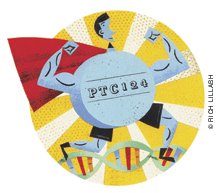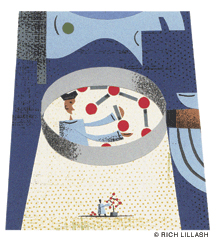Seniors: Get Help for Depression and Live Longer
While depression has already been linked to higher mortality rates, a new study led by Penn researchers found that older primary-care patients with major depression were 45 percent less likely to die in practices that implemented depression-care management than were similarly depressed patients in practices that did not treat for depression.
“Depression approximately doubles the death rate, even after accounting for medical conditions that might be present,” says Dr. Joseph Gallo, associate professor of family medicine and community health and the study’s lead author. “We think this is the first study to show primary-care-based intervention might affect mortality in older adults.”
The study, which followed 1,226 randomly sampled older patients, 396 of whom met the criteria for major depression, was published in the May 15 issue of the Annals of Internal Medicine; among its other authors are Dr. Hillary Bogner M’96 GM’01, assistant professor of family medicine and community health, and Dr. Knashawn Morales M’06, assistant professor of biostatistics. While most of the patients were treated with anti-depressant medication (citalopram) or psychotherapy, notes Gallo, “ultimately the care was up to the patient and their doctor.”
Curiously, the reduction in overall deaths appears to have been “almost exclusively” in the number of patients who died of cancer, the study notes. The mechanism for that effect is “not apparent,” add the authors, who caution that the elusive nature of depression can skew the findings.
In previous work, Gallo and his colleagues concluded that “if the mortality due to depression could be eliminated among older adults, approximately 13 percent of deaths would be prevented—about the same proportion as if the deaths due to diabetes or heart disease were eliminated,” he notes. “So the new study underscores the public-health significance of providing resources to help primary-care clinicians better manage psychological distress and psychiatric disturbances among older adults.”
—S.H.
A Drug for a Thousand Diseases?

Children afflicted with Duchenne muscular dystrophy (DMD) begin to show the effects of the inherited disease at about five years of age, when their pelvic muscles start to deteriorate. Those who reach 12 typically do so in wheelchairs. Gradually the disease cripples their respiratory muscles as well, and anyone who reaches 20 can be considered to have beaten the odds.
A recent finding by Penn researchers, along with colleagues from the University of Massachusetts and PTC Therapeutics, a pharmaceutical concern, may change those odds—as well as the outlook for sufferers of as many as 1,800 other genetic disorders.
Like a wide variety of inherited diseases, from cystic fibrosis to hemophilia, DMD arises from a gene mutation that interferes with the production of a crucial protein—in this case, dystrophin. About 13 percent of DMD sufferers cannot manufacture dystrophin because of a “nonsense mutation,” which basically causes the cell’s genetic factory to stop assembling the protein before it is complete. In an April paper in Nature, scientists described a new type of drug that effectively suppresses nonsense mutations in both human and mouse cells, enabling dystrophin to be produced properly. The drug also restored muscle function in afflicted mice after two to eight weeks of treatment, a breakthrough leading to human trials that are currently in progress, according to senior author H. Lee Sweeney, chair of the Department of Physiology.
The new compound, called PTC124, represents a novel strategy in drug discovery.
“This molecule was not designed to go after a specific disease—it was designed to go after a specific type of genetic mutation that can cause all sorts of disease,” says Sweeney. “It’s sort of like chemical gene therapy … We’re getting the body to reinterpret the defective gene and use it to actually make, for the first time in these people, a protein that was missing.”
If the human clinical trials go well, PTC124 may eventually bring hope not just to some children who have DMD, but to sufferers of “a very long list of rare metabolic diseases” that arise from nonsense mutations, says Sweeney. That would solve an economic problem as well as a medical one. Since profit-minded pharmaceutical companies have little incentive to focus on rare disorders, a single drug that could treat hundreds of them would be an especially fortuitous thing.
—T.P.
Sculpting at the Nanoscale

When discussing how a team from the Department of Physics and Astronomy uses an electron beam to hand-carve metal structures and devices whose dimensions are all less than 10 nanometers, it’s a good idea to define the terms. Since a nanometer is one billionth of a meter, terms like hand-carve and sculpt essentially translate to removing atoms.
Dr. Marija Drndic, assistant professor in physics and astronomy, and Michael Fischbein G’04 Gr’10, a graduate student in the department, used the electron beam produced inside a transmission electron microscope to “sculpt” metal nanostructures by removing atoms from very thin metal films. The technique is known as TEBAL—for transmission electron beam ablation lithography—and it has a number of advantages over other methods. One is that structures can be imaged with atomic resolution and inspected as they are created, resulting in structures with smooth surfaces that can be copied with great precision.
“We can see individual atomic layers being removed in real time,” says Drndic. “The electrons remove atoms by momentum transfer—they knock them off the surface.”
Unlike the “bottom-up” method of assembling structures from smaller components, TEBAL structures do not have to be placed on a chip and then connected to larger circuitry.
“Say you want to make a small disc and contact it with metal leads,” says Drndic. “In our case, you make the disc and the leads by carving them out. In the case of the bottom-up [technique], you first make a disc, then place it on some surface, and then you have to make the leads around it. But the disc is so small that making the leads that are actually connected to the disc is very difficult.”
Since all of the structures through the TEBAL technique were done by hand, computer control “should offer an even higher degree of precision than we’ve demonstrated,” Fischbein told Physorg.com.
So far, the team has created nanodiscs, nanorings, nanowires, and multi-terminal nanotransistors using TEBAL. Running an electric current through TEBAL-created nanowires could transform them into nanomagnets. Other applications, says Drndic, include “nanofluidics, molecular translocation studies, superconductivity, manipulation of atoms/particles with electromagnetic fields, and plasmonics.”
—S.H.




